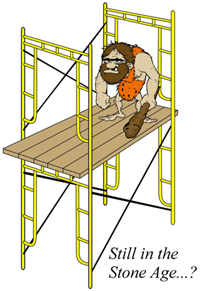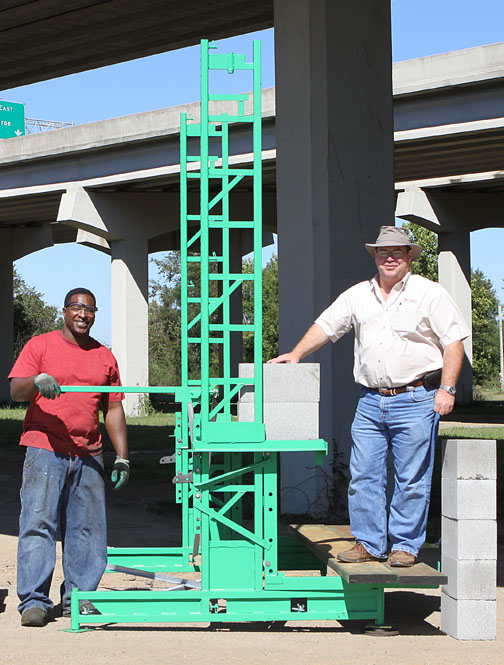WORKHORSE
You Don’t Have a Manpower Problem, You Have a Production Problem
Low Walls Are Now Money Walls
Low walls have long been the most expensive walls to build. Until Workhorse. Workhorse adjustable scaffolding turns walls only 6′ tall into profitable walls, by keeping the mason waist-high all the way to the top.
THE NEW WORKHORSE lets you get the extra production of crank-up scaffolding on ALL your walls.
Top out 11′-4″ walls from the first course to the last without stopping.
The top of this web page goes into the new features and advantages of our NEW WORKHORSE elevating scaffold. We re-designed our very popular WORKHORSE scaffold to make it even easier to use and transport. Farther down is our original WORKHORSE info. We’ll update this page as new job pictures come in. For now, here’s some in-plant pictures.
What’s New:
1. The NEW WORKHORSE has a 3′-8″ stub base (shown unpainted in the picture) rather than the old 9′-7″ base. The advantage is being a LOT more transportable. Now, you can actually knock it down and move it in a pickup. (Click on the picture to view it larger.)
2. The NEW WORKHORSE’s standard configuration is the stub base with one 4′-3″ extension. The total tower height is 7′-11″ so it’ll go anywhere. When it’s jacked as high as it goes, the masons’ feet will be 6′-5″ above the floor. The masons’ shoulders will be about 11′-6″ above the floor (the guy in the orange shirt is 5′-10″). We say he can top out an 11′-4″ wall easily.
3. The NEW WORKHORSE has a built-in hop board for the tenders. As the tenders jack the masons and their workbench up the tower, it will eventually get too high to reach. They put two boards on the hop board support and they can reach the workbench easily.
4. It’s easier to move inside a buildiing now. Each leg, as shown here, weighs only 153 lbs.
NO MORE RUNNING SCAFFOLD-HIGH
This picture shows how the NEW WORKHORSE adjustable scaffolding starts out on the ground. You bring WORKHORSE in first, before the wall is even laid out. DO NOT RUN YOUR WALL SCAFFOLD-HIGH. The workbench boards are put in place and stocked. The masons’ walkboards are tucked under the workbench so they’re ready when needed. (Click on the picture to view it larger.)
This is 12 legs (77 running feet) of Workhorse clamped together with our “Rack Brackets” that we also use for Heavy-Duty and Standard-Duty masonry scaffolding systems. Each leg consists of the stub base, 4′-3″ extension, and elevating carriage. It is 7′-11″ tall overall and less than 4 feet wide.
Most of our customers stand their Workhorse up on the front of their trailer and tie it to a headache rack. The old base unit was 9′-7″ high which made it too hard to transport move around inside.
New Inside Corner Workbench Bracket
Supports asdf the workbench boards running beside the tower on inside corners
Inside Corner Arm For Masons Boards
Turn ALL Your Short Walls Into MONEY WALLS with WORKHORSE. Go From Slab To Ceiling In One Shot, Without Stopping! And DOUBLE YOUR PROFIT!
We have commercial masonry contractor customers who own more than 200 WORKHORSES each! Why would they buy that many (they’re not cheap)?
Let’s look at why they have forbidden their men to use anything but WORKHORSE on all their interior walls and short walls:
1. We polled some of our customers and asked them what they figure per block for labor. The average was $14 per block. Let’s use $10 to keep it conservative. Now, frames make your masons stop twice to hop boards on an 11′-4″ wall. That’s 10 blocks (minimum) PER MASON lost every time they stop. That’s 20 blocks for 2 stops. For 4 masons, that’s 80 blocks per day lost. Therefore, 4 masons can leave 80 block x $10 = $800 on the table every day.
If you can’t agree with that, think of it as gaining 80 block per day per 4 masons. You’ll finish the job sooner than you figured, and all that payroll money (for the entire crew) you didn’t spent goes in your pocket.
2. The elevating scaffold advantage: When every course is waist high, masons lay more because it’s easier. When you combine the block you gain because you never stop, and the block you gain because they are laying in their sweet spot, our users say their walls go up 25% faster. They say it’s the same as getting the production of 4 masons from 3, and those 3 are going home less tired.
So what does that mean in terms of dollars? If 3 masons on WORKHORSE produce like 4 on frames, you have a real dollar savings of $3800 per month (national average mason cost). If you have 9 masons on WORKHORSE, you have a real dollar savings of $11,400 per month (if they were on frames, you’d pay out $11,400 more). In actual use, our customers say WORKHORSE adjustable scaffolding pays for itself in less than 8 weeks.
There’s more:
- Build Every Wall 6 to 20 Feet High At Least 25% Faster!
- Lightweight – 135 lbs – Moves By Hand. Roll It On Casters Inside.
- Easy To Access – Legal To Climb.
- Sets Up and Moves 4 Times Faster Than Frames
- Buy 105 Feet of WORKHORSE for 12-ft. walls for about $14,700. 8-week guaranteed payback.
- No-BS Lifetime Guarantee.
- See Job Pictures.
- Download the WORKHORSE brochure here.
1. WORKHORSE goes in first, before you ever lay your first piece of material. NEVER run a wall scaffold-high and move. Why? Because every time you stop and move your men, you sacrifice about $100 in lost production per mason (when the block stops, the money stops). Once they lay the first course on WORKHORSE, they don’t move untill the wall’s topped-out! Every time you start a wall, you’ll re-capture about $200 that’s always been a built-in loss on frames.
(Click on any picture to enlarge it.)
(Notice how the masons’ walkboards are stored out of the way under the workbench so they’re ready when he needs them. No more stopping production while the laborers walk all the boards in from the end. You simply pull out the walkboard support, slide the boards over, and keep working.)
2. When the wall gets scaffold-high, you simply move the boards over, and KEEP WORKING. On a 14-foot wall you will ELIMINATE 3 MORE STOPS to hop boards you would have to make on frames.
To get maximum production, the laborers should raise the scaffold every two courses of block, or every five courses of brick.
The Masons are always in their “sweet spot” laying the fastest with the least effort. That will double your profit.
(The jack handle moves from tower to tower and jacks the scaffold up in 1-3/4″ increments like a truck jack. It lifts up the mason and his workbench together.)
3. Laborers can pass materials up to the masons’ workbench from the ground. It’s easy to throw mortar on the boards with a shovel.
The laborers can cover the masons’ workbench up with materials before it gets out of reach. Then they jack the scaffold up one last time before adding the Laborers Bracket.
MASONS STAND AS HIGH AS 8′-3″ ON THE BASE TOWER ALONE, OR UP TO 12′-6″ ON THE BASE PLUS AN EXTENSION.
(Click on any picture to enlarge it.)
WORKHORSE masonry scaffolding is easy to jack up, even when loaded with materials. Watch it here.
4. As soon as the workbench is too high to reach, the laborers add a snap-on laborers bracket that gives them 4 boards worth of material stocking area – 3 behind the tower, and 1 cut-board between the towers. They can land 300 brick, a mortar tub, or full pallets of block.
When the base scaffold is jacked up as high as it will go up, your masons’ feet will be 8′-3″ off the ground, making it easy to top-out a 12′-8″ wall, maybe even 13′-4″.
If you add a 4′-3″ extension tower, you can put your masons’ feet at 12′-6″ to top-out about 17′-4″.
You can add another extension if you really want to, it’ll take your masons’ feet up to 16′-9″, but by then you should be using the Standard-Duty scaffold anyway.
Building walls this way will reduce your labor by at least 25%. That will double your profit.
Workhorse will make you a lot of money. In fact,
If WORKHORSE masonry scaffolding doesn’t pay for itself in 5 weeks, we’ll buy it back.
In this close-up shot of the Laborers Bracket you can see the cut-board it gives you between the towers. With a total of 4 boards, the laborers can stock materials ahead and have room to walk around them. The cut-boards are the same length as all cut-boards used on Non-Stop scaffolding.
Workhorse sets up like all other Non-Stop. X-braced towers are 7 feet wide, and towers are spaced 7 feet apart with a straight brace. This gives you a braced bay, then an open bay, etc.
(Click on any picture to enlarge it.)
Stock plenty of materials ahead with room to walk around them.
If you need them, all the Standard-Duty guardrail components can be used on Workhorse to meet all safety standards. However, using just the base unit, no one goes over 10 feet high.
Interior block walls are money walls with Workhorse. Start out on the ground working right off the scaffold and NO ONE EVER MOVES until you top out.
(Click on any picture to enlarge it.)
The workbench provides plenty of room for block or brick.
When everything is at the perfect height – the wall, the materials, the mortar board – and they never have to stop, your masons fly. They put in 30% more units with NO MORE BACKACHES. That will double your profit.
(Click on any picture to enlarge it.)





















